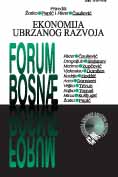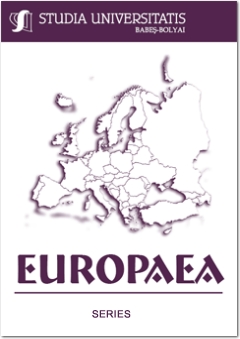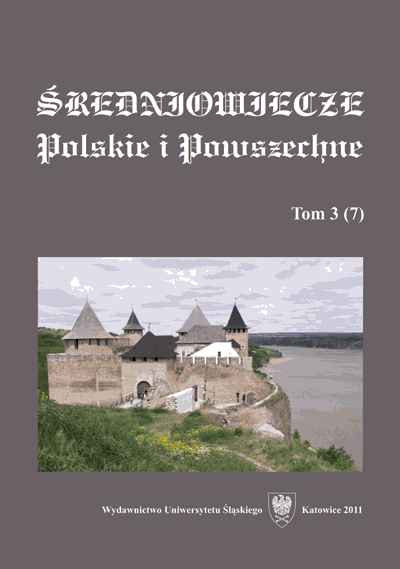


Keywords: intra-industrial trade; comparative advantages; competitiveness
Liberalization of foreign trade and regional integration, on the one hand, and restructuring of production and adaptation to the demand on the markets of the actual CEFTA and EU, on the other, contributed to dynamic growth of foreign trade of Bosnia and Herzegovina during the period 2002-2007. Dominant mode of Bosnia and Herzegovina’s foreign trade in year 2002 was inter-industrial exchange, based on comparative advantages. At the end of the observed period this becomes intra-industrial trade. This way the rule is affirmed that in the initial phase of economic development of a country foreign trade is dominantly based on comparative advantages, and that with further development the factors of competitiveness contributing to the development of intra-industrial trade get their significance. Dominancy of intra-industrial trade is displayed in trade within actual CEFTA and EU because of adequate adaptation of Bosnia and Herzegovina’s offer for export to these markets and because of a deeper integration of production from Bosnia and Herzegovina into the chains of values of production in these groupings. In trading with other countries, inter-industrial exchange remains dominant mode of trade. In the sector structure intra-industrial exchange dominates in industries with greater degree of fragmentation, technological content, and possibility for diversification of production. Future development of intra-industrial trade of Bosnia and Herzegovina will be defined by the dynamics of transitional and reform changes on the path of integration into the EU and by the tempo of restructuring and modernization of production for needs of demands in CEFTA and EU in the phase of development lead by efficiency with investments as initiators of growth of competitiveness.
More...
Keywords: Erasmus program; cross-cultural European experience; mobility; identity; cosmopolitism.
The present article aims to interlink the following aspects related to cross-cultural European experiences: the educational mobility, as a subtype of modern physical and cultural flexibility, the cosmopolitan identity and values, to whom this type of mobility can give birth to, in similar circumstances all over the continent, and the way these are shared by individuals. The paper draws on the empirical research performed in an intercultural community, amongst Erasmus students incoming to Bordeaux, France, during the former academic year.
More...
Herman von Gleichen, being a bishop in Kamieńsk between 1251 and 1289, has caught the attention of the historians for many years. It is because of diversified aspects of his activity. The very activity covered the period of strengthening the influence of Brandenburg margraves on Western Pomerania and claims to his liege control of Middle and Eastern Pomerania many a time articulated by Askańczyk dynasty. Herman took office as bishop not only thanks to an election of the chapter from Kamieńsk, which was successful for him, but also due to his origins and political connections with a German party co-working with a German anti-king Wilhelm from Holland. The very party comprised a Brandenburg dynasty of Askańczyk, princes from Brunszwik, Saxon princess and earl of Anhalt. An important factor supporting Herman von Gleichen’s career was family connections, from which he originated, and a Danish king Eryk and his circle. One of the priorities of politics conducted by bishop Herman was his willingness to maintain the appropriate relations with Brandenburg margraves and being against their control of Western Pomeranian princes many a time. The very aim was realised by a bishop during life and ruling of Warcisław the Third and Barnim the First (eventually till 1278). A balance of bishop’s politics turned out much more unsuccessful in the period of ruling of the sons of Barnim the First, especially the oldest one, Bogusław the Fourth (d. 1309). He made at least several attempts to leave a liege control of a Brandenburg dynasty of Askańczyk. Much less favourable was perceived an autonomous politics by a bishop from Kamieńsk. Tomasz Kantzow, a 16th century Pomeranian chronicler accused even Herman von Gleichen of his co-work with Brandenburg margraves hostile to Bogusław the Fourth. The chronicle opinion, cited in the light of the diplomatic material retained, seems not to be totally fair for the evaluation of the whole of Herman von Gleichen’s activity. It may, at best, concern one of its excerpts.
More...
An inclusion of Dobrzyń in the form from 1392 by the Teutonic Knights led to a polarization of the gentry of the elite in question. The party approving of the order authorities constituted the majority of the representatives of the Dobrzyń line of Ogon family led by an unquestionable leader of this family circle, notably Andrzej of Radziki, a castellan from Dobrzyń. Likewise, Piotr Świnka the First, a senior of Świnka family, and a castellan from Rypin, brought with him all relatives. A different story was in the case of the family of Pierzchała from Radomin, where the oldest son of marshal Iwan, one of the leaders of the pro-knight camp, Piotr who entered the service of Władysław Jagiełło before pledge, remained there also between 1392 and 1405. The kingdom party comprises the most important representatives of the line of Dołęga, who joined their senior judge Andrzej Słup en masse, although some of them were in Dobrzyń (master of the hunt Kanimir, Stefan from Wierzbicko, Jan Kretkowski) during the knight authorities. Similarly, in the kingdom party and emigration beyond Dobrzyń were all Leszczyce from Dobrzyń: brothers Kosisko. The sources concerning political behaviours of Jastrzębce from Dobrzyń also show that they are in favour of the Kingdom (Chełmicki and Grochowalski families) rather than among knight advocates. Slightly different was the situation in the line of Godziemba from Dobrzyń. In which Bierwołd from Głowina chose allegiance to the Kingdom emigrated beyond Dobrzyń while Jakub from Maliszewo remained in Dobrzyń during the knight authorities and even was a witness of many documents issued there. Different political choices can also be seen in the case of two knight families which possessed lands from Dobrzyń during the ruling of Władysław Opolczyk. Piotr Lebel from Osiek chose the service at the Teutonic Knights whereas older Janusz Sztembarski was in favour of Władysław Jagiełło. The family of Rasz from Starorypin, deriving from Prussia and possessing family lands there, on the other hand, approved of the Teutonic Knights.
More...
The territorial divisions of Russia Rubra has already been studied by researchers. However, a reliable and holistic coverage of these issues is still missing. The very article, by the example of the Lviv area, shows a complicated and dynamic process of the formation of a territorial divisions of Russia Rubra, especially its multi-stagism and multi-structure noticed by the latest literature. The division in question was not homogeneous and stable, but was actively shaped. An Old-Russian system of settlement was being slowly and evolutionally replaced with a division into medieval town circles (districtus, a district) used in the management and administration of the province. A dynamic division into circles became a basis for other territory structures, a division into voivodships, lands, districts as well as medieval starosty in the 15th century. The Lviv area in the course of the changes was composed of six such circles, three medieval starosties and two districts.
More...
The issue of increasing Turkish danger was the subject of concern for King Kazimierz Jagiellończyk until spring 1489 when after military and diplomatic actions a 2-year treaty was formed with Turkey. The author presents a stand of Royal Prussia and Gdańsk, one of the richest towns of Polish Duchy, towards the issue in question.
More...
The article reviews the history of the peasant community inhabiting Lubycza in the OldPolish Bełz voivodeship, in the area of a widely understood Polish-Russian borderline between the 15th and 19th centuries. It follows from the considerations that there were the situations when particular peasant communities, their elites, to be more specific, manage to maintain privileges dating back to the Middle Ages, including economic and legal freedom, deriving from the settlement location on terms of Wallachian Law, despite pressure from the outside and economic-social trends dominating in the Old-Polish period. Further studies should concentrate on not only defining the scale of the very phenomenon, but also possibly showing the areas where the situations, like in Lubycza, happened more often. Currently, one can only presume that their existence could result from the location of such rural settlements at the borderlines understood not only in an ethnic, but also civilization sense. It is also unknown if this “experience” of the Middle Ages concerned royal lands exclusively or other categories of possession too.
More...
The article presents the functioning of a rural elite in Konopnica, a village situated in the area of a domination of a big urban centre, that is Lublin, on the example of two peasant families. It derives from the considerations that the social group, like in other settlements, comprised people characterised by a good material status, unblemished reputation and high regard among the remaining inhabitants. The evidence was numerous examples of their positions in a rural self-government and their nomination to guarantors in neighbours’ arguments and looking after orphan children. In the case of a suburban village, however, the neighbourhood of a town gave possibilities of gaining high incomes, higher than in other settlements, which was a condition to be in the elites. Untypical were also sources of wealth which in the case of peasant elites was usually the effect of incomes from a sufficiently big acreage of plowing fields and, possibly, craft services. In the case of Konopnica, an emphasis was put rather on the exploitation of the possibilities of becoming rich via a close proximity of the market for the products from their own farm.
More...
The author discusses the most important centres of an intellectual culture in the Middle-Aged Bardiów, namely: a local parish school dated back to 1434, a well-equipped library, existing at a parish church, including over 30 manuscript books in the 15th century and over 100 volumes a half century later, and, finally, a circle of book copyists and miniaturist among whom the most outstanding copyist was Jan Schwarz (his manuscript Liber fratris Johannis Hungari de Bartpha can be found in a University Library in Wrocław) and miniaturist Baltazar Blutfogel. An intellectual resilience of Bardiów is ascribed to people studying at the Cracow University and going back home after studies. A Cracow University became a breeding ground for the staff not only for a parish school, but also a local office. Also local priests held a university education.
More...
Cultural influences on borderline area have fascinated people since the ancient times. A border, as a magic zone, separates what is known and familiar from what is different and often incomprehensible. It has always been a unique space, often suspended between „us” and „them”, between „our” and „their” culture, inspiring the creation of new values and cultural substrates. Silesia, as a borderline region was a place of a „clash” of different cultural „tectonic” surfaces, and, thus, the development of a specific community. The very process can be observed while investigating an attitude of Silesian elites towards Western-European cultural models in the 13th century, when a substantial attenuation of a central administration and a collapse of the idea of a country allowed for being opened to new trends, influences and fashion. And it did not have to mean, as an old historiography wanted, a Germanization or (de)Polonization, but localization, understood as the formation of a unique culture through processes of exchange, integration and permeation. A contemporary researcher can notice it at best on the example of sfragistic, heraldic or iconographic sources, but also influence on the literature, language or the most popular cultural motives.
More...
In ihrem Artikel ergründet die Verfasserin die von Michailo Hruszewski herausgearbeitete Beurteilung des Herzogs Wladislaus I. von Oppeln, der in der ukrainischen Historiographie für den letzten selbständigen Herrscher des Fürstentums Halytsch-Wolhynien gehalten war, bevor dessen Gebiete schließlich an das Fürstentum Polen angeschlossen wurden. Die Grundlage ihrer Untersuchungen sind die politische Geschichte des Mittelosteuropas und besonders polnisch-ungarische Wechselbeziehungen. Die Ansichten von polnischen und ukrainischen Historikern miteinander konfrontierend und herzogliche Urkunden untersuchend schildert sie nicht nur die Beurteilung von der Herrschaft und der historischen Rolle des Oppelner Herzogs in Rotruthenien in den Jahren 1372—1379, wie die von M. Hruszewski in der ukrainischen Historiographie dargestellt wurde, sondern nimmt auch ihre eigene Stellung zum Problem ein.
More...
The article is an attempt to show elites of small cities from the point of view of microhistory. The author investigated the subject in question by means of statistical methods (which strongly highlighted the majority of issues connected with personal rotation within the scope of municipal authorities), but also managed to present “living” figures (which was to specify factors accelerating career development, such as connections, affluence, resourcefulness, especially predispositions, etc.). For the purposes of narration clarity, a certain symbolic and much simplified model of this urban community actively participating in the life of the city (a circle of people connected with the owner of the city, a circle of the most prominent families, and a circle of pre-townsmen) was created. Much attention was devoted to the process of permeating peasants into an urban community and a fixed representation of peasants inhabiting the suburbs of Kamionka in a body of town councilors. The problem of the migration of urban population “from” and “to” other places was dealt with. On the basis of several examples, a diversity of contacts between townsmen from Kamionka and other centres (family and economic connections, etc.) was shown. In conclusion, the author states that characteristic features of provincial elites involved a big personnel rotation within the authorities, a high mobility of the most influential townsmen and their relatively good material position.
More...
The person of Ryksa, the only child of a Polish king Przemysł the Second, has caught the attention of the historians for years. Still, though, some moments of her extremely interesting life, bring about interpretation difficulties. Presenting life and activity of a princess from Wielkopolska, the author makes an attempt to answer a series of questions concerning her marriage with a Czech Wacław the Second and his acceptance of the Polish Crown, as well as her life as Elżbieta in the Czech Republic later on (she is known there under the very name). Hypotheses and facts related to her earlier marriage plans and next relationships after an early death of Wacław the Second (d. 1305) are introduced.
More...
Keywords: clergy; Szadek
More...
Keywords: Szadek; Old Polish period
More...
Keywords: Szadkowskie Koło Zjednoczonych Ziemianek
More...
Keywords: Tomasz Szadek; composer; singer; priest
More...
Keywords: seal; Sieradz; Szadek
More...
Keywords: Józef Leopold; Rzepiszew; library
More...